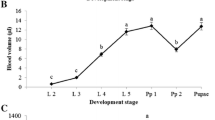Abstract
The branchial gland of the dibranchiate cephalopods is described as the site of haemocyanin synthesis. Because there is no equivalent to this organ in tetrabranchiate cephalopods the localization of haemocyanin synthesis remained unknown for a long time. In this study we could confirm the conclusions from prelimnary investigations concerning the copper content of the midgut gland ofNautilus, which gave the first indications for a possible localization of haemocyanin synthesis in this organ. We developed a polyclonal antibody againstNautilus haemocyanin, tested its specificity, and used it on ultra-thin sections of the tissue of the midgut gland. It could be shown that there is a clear imunogold precipitation only on the triangular basal cells in the terminal alveoli. All the other types of cell in this organ were free of any immunoreactivity. It can be supposed that the triangular basal cells in the terminal alveoli of the midgut gland are the sites of haemocyanin synthesis inNautilus.
Similar content being viewed by others
References
Fahrenbach, W. H., J. Cell Biol.44 (1970) 457.
Markl, J., Stumpp, S., Bosch, F. X. and Voit, R., in: Invertebrate Dioxygen Carriers, pp. 497–503. Eds G. Préaux and R. Lontie. Leuven University Press, Leuven 1990.
Préaux, G., Vandamme, A., Béthune, B., Jacobs, M. P., and Lontie, R., in: Invertebrate Oxygen Carriers, pp. 485–488. Ed. B. Linzen. Springer Verlag, Berlin and Heidelberg 1986.
Senkbeil, E. G., and Wriston, J. C. Comp. Biochem. Physiol.68B (1981) 163–167.
Hennecke, R., Gellissen, G., Spindler-Barth, M., and Spindler, K. D., in: Invertebrate Dioxygen Carriers, pp. 503–506. Eds G. Préaux and R. Lontie. Leuven University Press, Leuven 1990.
Ghiretti-Magaldi, A., Milanesi, C., and Salvato, B., Experientia29 (1973) 1265.
Sminia, T., and Boer, H. H., Z. Zellforsch.145 (1973) 443.
Sminia, T., and Vlugt-van Daalen, J. E., Cell Tissue Res.183 (1977) 299.
Dilly, P. N., and Messenger, J. B., Z. Zellforsch.132 (1972) 193.
Schipp, R., Höhn, P., and Ginkel, G., Z. Zellforsch.139 (1973) 253.
Taki, I., J. Fac. Fish. Anim. Husb.5 (1964) 345.
Saure, H., Schipp, R., and Magnier, Y., Zool. Jb. Anat.116 (1987) 39.
Ruth, P., Schipp, R., and Klüssendorf, B., Zoomorphology108 (1988) 1.
Linné, K., Systema Naturae10 (1758) Stockholm.
Bradford, M. M., Analyt. Biochem.72 (1976) 248.
Friemel, H., Immunologische Arbeitsmethoden. Fischer Verlag, Stuttgart 1984.
McKinney, M. M., and Parkinson, A., J. Immun. Meth.96 (1987) 271.
Ouchterlony, Ö., and Nilsson, L. A., in: Handbook of Experimental Immunology. Ed. D. M. Weir. Blackwell Scientific Publications, Oxford 1978.
Laemmli, U. K., Nature, Lond.227 (1970) 680.
Humphrey, C. D., and Pittman, F. E., Stain Technology49 (1974) 9.
Reynolds, E. S., J. Cell Biol.17 (1963) 208.
Vardell, I. M., Tapia, F. J., Probert, L., Buchan, A. M. J., Gu, J., DeMey, J., Bloom, S. R., and Polak, J. M., in: Techniques in Immunocytochemistry, vol. 3, pp. 16–154. Eds G. R. Bullock and P. Petrusz. Academic Press, London 1982.
Bonaventura, C., Bonaventura, J., Miller, K. I., and Van Holde, K. E., Arch Biochem. Biophys.211 (1981) 589.
Schipp, R., and Hevert, F., Marine Biology47 (1978) 391.
Ruth, P., Blum, W., and Bille, J., Verh. dtsch. Zool. Ges.85, 1 (1992) 278.
Schipp, R., and Pfeiffer, K., Zool. Jb. Anat.104 (1980) 317.
Henning, W., Phylogenetic Systematics, Univ. Illinois Press, Urbana 1966.
Nielsen, C., in: Animal Evolution, Interrelationships of the Living Phyla, pp. 110–123. Ed C. Nielsen. Oxford University Press, Oxford, New York, Tokyo 1995.
Author information
Authors and Affiliations
Rights and permissions
About this article
Cite this article
Ruth, P., Blum, W. & Bille, J. Immunocytochemical reaction of a haemocyanin antibody in the midgut gland ofNautilus (Cephalopoda, Tetrabranchiata). Experientia 52, 549–553 (1996). https://doi.org/10.1007/BF01969726
Received:
Accepted:
Issue Date:
DOI: https://doi.org/10.1007/BF01969726




